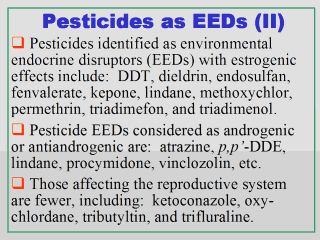| front |1 |2 |3 |4 |5 |6 |7 |8 |9 |10 |11 |12 |13 |14 |15 |16 |17 |18 |19 |20 |review |
 |
As mentioned in
the preceding slide, the website
www.ourstolenfuture.org
is a spin-off of the book Our Stolen Future (Colborn et al.,
1996). According to this website, pesticides that have been considered or
suspected as estrogenic are: DDT, dicofol, dieldrin,
endosulfan, fenvalerate, kepone, lindane,
methoxychlor, permethrin, triadimefon, and triadimenol.
Also listed as estrogenic are the food antioxidant BHA (butylated
hydroxyanisole), the phthalate compounds bisphenol A and
bisphenol F, and the persistent organohalogens dioxins, furans,
and PCBs. The fewer pesticides listed as androgenic or antiandrogenic on that website are: atrazine, p,pí-DDE, lindane, procymidone, and vinclozolin. Other chemicals not used as pesticides, such as PCBs and some phthalate compounds, are also listed as androgenic. The reproductive system is the last of the more prominent places in the body where pesticides and other persistent organochlorines are listed on the website as having the ability to disrupt hormone levels. Endocrine disruptors in this group include the pesticides ketoconazole, oxychlordane, tributyltin, and trifluralin, and the non-pesticides BHC (benzenhexachloride), 1,2-dibromoethane, chloroform, PCBs, carbendazim, lead, and mercury. For an understanding of the actual disruption mechanisms involved, students are referred to the supporting references listed on that website. They may start with the work by Soto et al. (1994) and by Hurley et al. (1998). In fact, many of the supporting references cited on that website were journal papers published in Environmental Health Perspectives. |